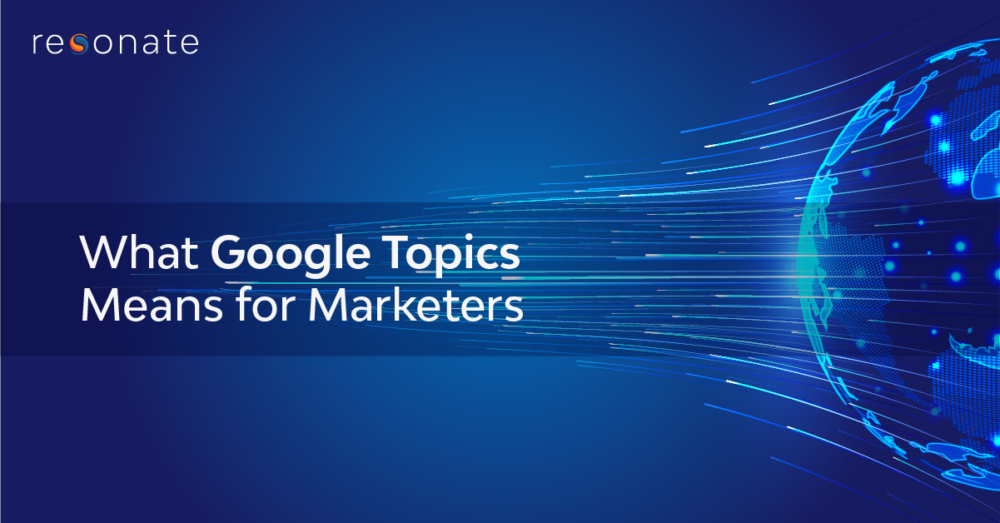Now that Google’s original third-party cookie replacement is no more (RIP FLoC), marketers are taking a closer look at the newer alternative: Google Topics. And it might make things more difficult for advertisers when it comes to ad targeting. Here’s what you need to know.
What is Google Topics?
Let’s break down Google’s latest attempt to balance preserving people’s privacy and companies’ abilities to buy and sell targeted ads. You might remember that the FLoC (Federated Learning of Cohorts) approach grouped people by specific interests (impulse shoppers, new home buyers, etc.) based on their browsing history. Unfortunately, their attempt to ease privacy concerns actually grew privacy concerns. The company was under fire from ethics researchers and lawmakers for discriminatory potential.
The newer Topics similarly proposes targeting ads to people based on the categories of content they view online and containing this categorization to the device. However, unlike FLoC, Google Topics presents a more general level of categorization. In Topics, categories are aggregated from the articles people are reading about, such as investing, travel, and sports. There are 350 interest groups in Topics, of which each publisher site can only have three categories.
How does the new ad targeting proposal work?
There is a lot of speculation about how this new ad targeting feature works, but we have a general set of directions to work with now. So, without getting too into the weeds, let’s go over how Google Topics works both on the company/organization side and on the consumer side.
- A web browser will use the Topics API to define topics that best reflect a consumer’s interests based on what they browse online, such as “theme parks,” “news,” and “baby clothes.”
- The browser will decide a website’s topic based on its hostname, but companies may have the option of claiming which topics to associate with their websites.
- Every week, a browser will pick five topics per person and then choose one topic to assign to that person.
- Each topic is kept for three weeks, so when a person visits a website, the site can use the Topics API to access up to three topics for that site visitor.
Important things to note:
- Websites and their ad tech firms can only access topics related to the given website or other websites carrying the ad tech firms’ code.
- One of the five weekly topics a browser selects will include a random topic meant to throw off companies trying to snatch a person’s identity.
- Consumers may have the option to adjust the topics assigned to them and will also be able to disable this targeting feature altogether.
Should marketers worry now or later?
As you can imagine, not everyone is excited about Google Topics, particularly marketers. According to Digiday, advertisers and media owners have voiced concerns that Topics’ lack of granularity will limit ad targeting. This could result in limited or even lower ad prices, with advertisers having to pay more for more targeted ads.
But, should you worry?
There’s always time to worry, but, at Resonate, we prefer you’re prepared instead. While you likely won’t have the capacity to recreate the granular insights you got from third-party cookies using Topics, you’ll have other efficient targeting solutions available—starting with the data you already have. First-party data solutions will be invaluable, and marketers can use them to make the most of their own proprietary data.
What’s the alternative?
If you’re one of the many savvy marketers committed to becoming more self-sufficient, finding stability within marketing plans, and creating successful campaigns, take full advantage of your first-party data with privacy-safe, rich insights.
However, if you don’t know how to get the most out of your first-party data, there are resources and solutions available to you. And if you’re unsure whether you have enough first-party data to power your marketing, with an AI-powered consumer intelligence solution, you can truly understand the who, what, when, where, and why behind your audience’s decision-making and drive growth at all stages of the customer lifecycle.
Resonate can help you enrich your understanding of customers and prospects with a set of curated Resonate attributes including psychographics, behavioral, preferences, intent, and more. Using our AI-powered consumer intelligence solution, you can truly understand the who, what, when, where and why behind your audience’s decision-making and drive growth at all stages of the customer lifecycle. Onboard your data to the easy-to-use Resonate Ignite Platform or upload our data to your database for immediate access to granular, fresh insights that are both actionable and relevant to your brand. Curious how you can bypass the incoming challenges of Google Topics with Resonate? Talk to us.
Categorized as: Agency, Brand, Digital Advertising


